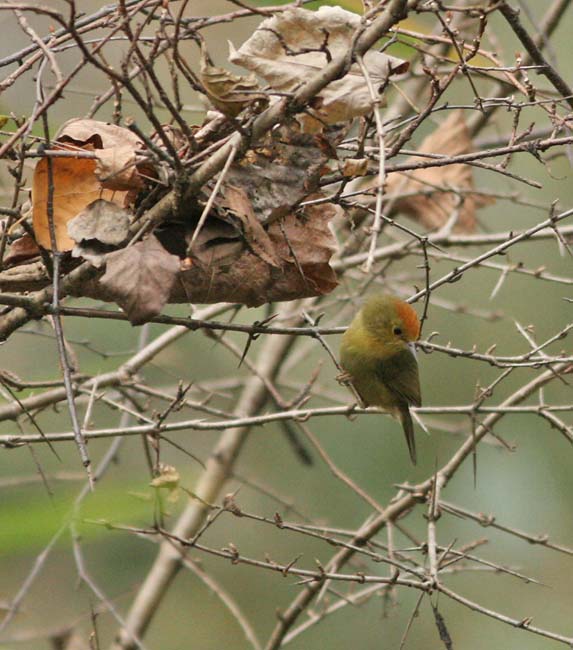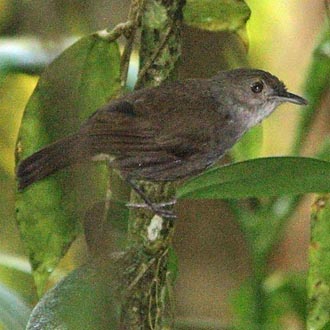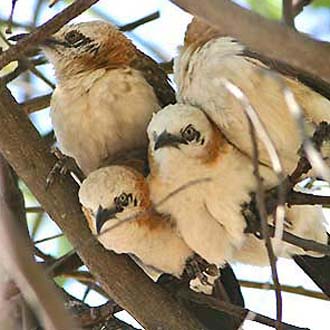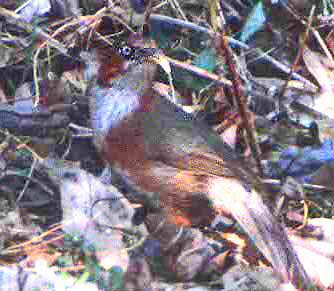
a web page by Don Roberson |
TREE BABBLERS & SCIMITAR-BABBLERS Timaliidae |
|||
|
|||
Babblers were once considered a huge family of over 300 species. Studies in the mid-2000s began to clarify the situation (e.g., Cibois 2003, Alström et al. 2006, Jønsson & Fjeldså 2006). Genetic evidence revealed that the Sylvia warblers — the original genus in the 'Old World Warblers' Sylviidae — were more closely related to Babblers than other Old World Warblers [see a discussion of the break-up of the Old World Warblers]. Additional research, especially Gelang et al. (2009), led to a "break-up of the Babblers." Cibois et al. (2010) summarized the outlines for five babbler families: tree babblers and scimitar-babblers [Timaliidae], sylvid babblers and parrotbills [Sylviidae], white-eyes [Zosteropidae], fulvettas and ground-babblers [Pellorneidae], and laughingthrushes [Leiothrichidae]. More recently, Moyle et al. (2012) confirmed the major clades in the babbler assemblage, but recommended that the tree-babblers, laughingthrushes, and the ground-babblers, be considered subfamilies of an expanded Babbler family [Timaliidae]. One of the reasons had to do with the amount of evolutionary time with the other related Families remaining the Sylvids and the White-eyes. I liked that approach and followed it for several years, and offered these three clades as subfamilies: |
|||
The core babblers split from the White-eyes and relatives in the early Miocene, estimated at 16–21 million years ago (mya; Moyle et al., 2012). Although that is a long time ago, it is not nearly as old as, for example, the Family level groups in the broadbill assemblage [African & Green Broadbills, Asian & Grauer's Broadbills, Asities, and Sapayoa in the New World] that diverged 45–56 mya (Moyle et al. 2006). So a Family level at perhaps 20 mya or has not been on its own evolutionary path as long as many bird families. My feeling is that something that diverged in early Miocene (about 16-23 mya) is a good guideline for a minimum of age of what we call a Family. The three main clades of the core babblers — the tree-babblers & scimitar-babblers, the laughingthrushes, and the ground-babblers — began diverging 11.2–17.8 mya (Moyle et al. 2012), so are right at that border. The main African radiations among babblers are even younger: the origin of the Illadopsis babblers is 10-14 mya, and the radiation of Turdoides babblers to Africa is 6.4-9.9 mya. These latter divergence times recall those of the ancestor of today's Wrentit Chamaea fasciata of western North America, which began diverging from its parrotbill ancestors about 6.5-8.1 mya (Burns & Barhoum 2006). This puts some perspective on the scale of evolution. Yet, more recently, Barker et al. (2013) reviewed the nine-primaried passerines in the New World, and proposed splitting them into as many as 16 families, some of those families as young as just 9–10 million years old. From that perspective, the three-way split of babblers at 11–17 mya is no longer so dramatic. Most global checklists have adopted the three-way split, so — once again — so do I (with some reluctance). |
|||
Whatever your preference as to what constitutes a bird Family, all the recent research has combined to give us a much better appreciation of the relationships of many birds. It is especially interesting to understand what is not a babbler: Some earlier dramatic findings included:
And yet beyond all this, many traditional babbler genera have proved to be paraphyletic (e.g., Stachyris is now split into 4 genera; Moyle et al. 2012). Thus the entire Babbler "apple-cart" has been turned over, sorted out, and reassigned as the evolutionary relationships have been sorted out. It is still a very large group of Asian and African birds, but today's Babbler family bears only partial resemblance to the 'traditional' babblers of yore. |
|||
Turning to what remains of the family Timaliidae, the tree babblers in genus Stachyris and Stachyridopsis are among the few "true" babblers still assigned to this family. Even the traditional 'tree babbler' genus Stachyris proved to be paraphyletic, and has been split into at least four genera, with only Stachyris and Stachyridopsis assigned to the Timaliidae. The remainder, all Philippine genera, are now considered related to white-eyes in the Zosteropidae, except that Moyle et al. (2012) found that the two miniature tit-babblers in the Philippines, assigned to genus Micromacronus, are not babblers at all. Stachyris once had 28 species; now it has but 13. The old genera Stachyridopsis, which is now changed to Cyanoderma [with "Stachyris" chrysaeum included; Moyle et al. (2012)], has six species. All these changes have left only a 50 species in ten genera among the down-sized Timaliidae. Included is the namesake single species in genus Timalia, the Chestnut-capped Babbler T. pileata of swampy areas from Nepal to China to Java. Six tit-babblers from southeast Asia and the Greater Sundas form genera Mixornis (4 species) and Macronous (2 species); see Moyle et al. (2012); and there are single species in monotypic genera Dumetia (Tawny-bellied Babbler D. hyperythra) and Rhopocichla (Dark-fronted Babbler R. atriceps). |
|||
One big surprise in Gelang et al. (2009) was that one of a half-dozen genera of wren-babblers — the four species in genus Pnoepygidae — were not within any babbler lineage. They recommended a new family, the Pnoepygidae, for those tiny, short-tailed, "wren-babblers," which are now called Cupwings. The remaining genera that are called wren-babblers (e.g., Rimator, Ptiolcichla, Kenopia, Napothera, Spelaeornis) are babblers, and most are now assigned to the Pellorneidae. But as it turns out, according to research by Moyle et al. (2012), the six wren-babblers in genus Spelaeornis actually belong to this family [Timaliidae]. These are Bar-winged Wren-Babbler Spelaeornis troglodytoides, Tawny-breasted Wren-Babbler S. longicaudatus, Naga Wren-Babbler S. chocolatinus, Chin Hills Wren-Babbler S. oatesi, Gray-bellied Wren-Babbler S. reptatus, and Pale-throated Wren-Babbler S. kinneari. Most of the wren-babblers are ground-loving species, elusive and difficult to observe in the forest understory. Most of these are quite small, chubby, long-legged birds with various patterns of spots or streaks in brown, blackish, or rufescent plumage — Asia's version of gnateaters. |
|||
In central China, Streak-breasted Scimitar-Babbler Pomatorhinus ruficollis
often occurs in mixed foraging flocks of babblers, parrotbills, and
warblers. Its loud calls are often the first notice one has that a
flock is nearby. Recent discussions have suggested that it be split
into several species. It will take some time for the dust to settle
from the "break-up of the Babblers." |
|||
Photos: The Rufous-capped Babbler Cyanoderma ruficeps was photographed in Foping Nature Reserve, Shaanxi, China, on 13 Nov 2010. The Rusty-cheeked Scimitar-Babbler Megapomatorhinus erythrogenys was at Sat Tal in the Himalayan foothills of Uttar Pradesh, India, in March 2001. Photos © Don Roberson; all rights reserved. Bibliographic notes There is no recent "family book" covering the tree-babblers but good coverage of the various babbler families, including the current Timaliidae, is in Collar & Robson (2007). The account is wonderful, with exceptional photos, although it could not be quite up-to-date with the most current taxonomic findings. Literature cited:
|
 In
the Old World tropics live hundreds of elusive small to mid-sized birds
— babblers! Often first located by sound, many species are elusive in
the shadows and undergrowth, even where they are common, but others are
found among mid-canopy flocks in woodlands. One of those is Rufous-capped Babbler (left), a common member of mixed species flocks in Asian mountains from the Himalayas to central China.
In
the Old World tropics live hundreds of elusive small to mid-sized birds
— babblers! Often first located by sound, many species are elusive in
the shadows and undergrowth, even where they are common, but others are
found among mid-canopy flocks in woodlands. One of those is Rufous-capped Babbler (left), a common member of mixed species flocks in Asian mountains from the Himalayas to central China. 


 This leaves 15 species of scimitar-babblers in the genera Pomatorhinus and Megapomatorhinus to round out family Timaliidae. Scimitar-babblers
are undergrowth species and have long decurved bills used to work through the leaf litter —
very like the thrashers of North America which they resemble in
size and body shape. An example is Rusty-cheeked Scimitar-Babbler
(right) of mountain foothills from India to n. Thailand. Like all birds
of shady habitats, it is difficult to snap a photo without a complex
flash set-up but perhaps you can get an idea of this group from this
white-eyed, pale-billed species.
This leaves 15 species of scimitar-babblers in the genera Pomatorhinus and Megapomatorhinus to round out family Timaliidae. Scimitar-babblers
are undergrowth species and have long decurved bills used to work through the leaf litter —
very like the thrashers of North America which they resemble in
size and body shape. An example is Rusty-cheeked Scimitar-Babbler
(right) of mountain foothills from India to n. Thailand. Like all birds
of shady habitats, it is difficult to snap a photo without a complex
flash set-up but perhaps you can get an idea of this group from this
white-eyed, pale-billed species.